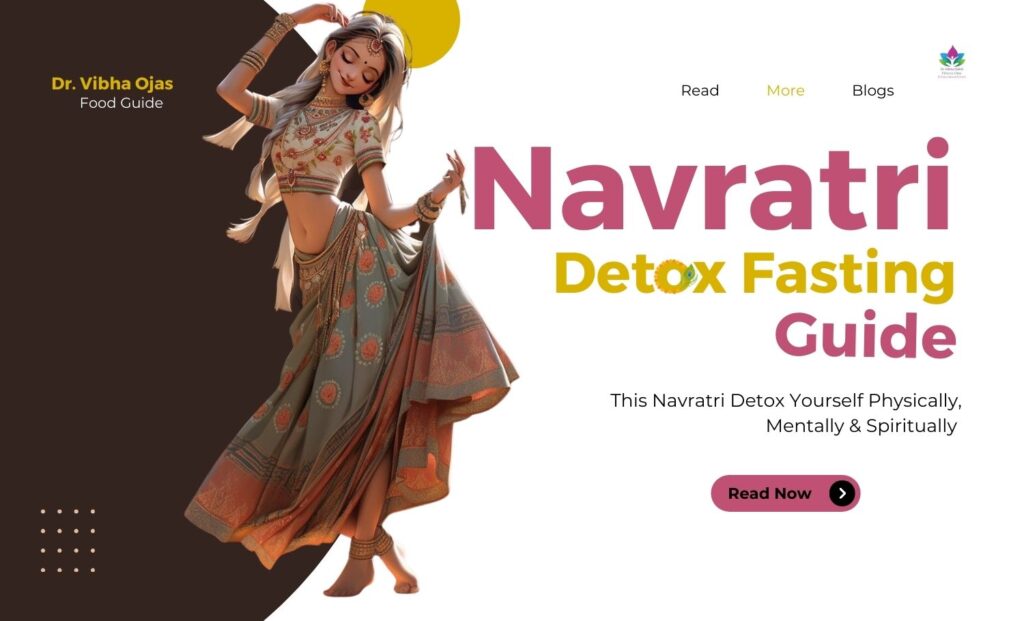Navratri is a sacred occasion that offers us a unique opportunity to embark on a holistic journey of self-purification. It is a time to cleanse our body, mind, and spirit, to rejuvenate our inner selves with the healthy Navratri fasting tips. We dedicate ourselves to worship of the Goddess, we also devote precious moments to our own well-being. Through prayer, meditation, and fasting, we not only detoxify our physical bodies but also purify our thoughts and emotions. This spiritual celebration allows us to reset our priorities, find inner peace, and strengthen our connection to the divine. Let us embrace this special time to nurture our overall health and find the harmony that lies within us.
In this journey the best dietitian in Chandigarh is here with the guide of fasting, With their support, we can embark on this spiritual detoxification with confidence. Let’s nourish our bodies in a way that aligns with our devotion and commitment to well-being.

Navratri Diet For Weightloss: 9-Day Fasting Diet Plan
Meal 1/Early Morning
Start your day with a refreshing glass of lemon water or cardamom-infused water. Follow it up with a handful of four almonds and your choice of an apple or papaya. Wait for about 15 minutes after consuming the lemon water or cardamom water.
Navratri fasting is commonly believed to enhance our immune system’s ability to combat foreign viruses. Contrary to the misconception that Navratri fasting may weaken immunity, there is a scientific rationale supporting its potential to strengthen our immune response. Let’s explore some words by the best dietitian in Panchkula for the Navratri diet to understand its benefits better.
Meal 2/Breakfast
For breakfast, you can opt for a fruit chat or have papaya, apple, or anar (pomegranate) raita.
Meal 3/Mid-Morning
Rehydrate with a serving of coconut water and enjoy three almonds and one walnut as a nutritious snack.
Meal 4/Lunch
Aloo Raita, Paneer stuff, Anar Raita + Kutu Roti (Buckwheat), Tofu (Not For Thyroid/Pcod/Pcos) , Sabudana Khichdi, Samak Rice, Makhane Ki Subzi + Buckwheat Chappati, Amaranth (Rajgira) Chapati + Aloo Subzi
Meal 5/Early Evening
Lassi + Fruits + 5 Makhane (Fox Nuts)
Meal 6/Late EvenGreen Tea+Lemon + 5 Almonds
Meal 7/Dinner
Sauteed Vegetables (No Salt)
Or Ghiya Kheer (No Sugar) Or Buckwheat Curry
Meal 8/Post Dinner
Hot Water + Lemon
NOTE: YOU CAN SKIP PARTICULAR INGREDIENTS THAT YOU DON’T CONSUME DURING THE FAST AS PER RITUAL.
Do’s
– Stay Hydrated
– Have Enough Fruits and Vegetables
– Have a Balanced Diet
– Keep Moving
Foods to be avoided for Navratri fast:
-Avoid onion and garlic. If you find any recipe in a food blog that has onion and garlic then skip adding them. So most Vrat recipes make use of curd and ginger.
-No lentils and legumes.
-Common salt is not used and instead, rock salt or sendha namak also called as upvaas ka namak is used.
Turmeric (haldi), asafoetida (hing), mustard (sarson or rai), fenugreek seeds (methi dana), garam masala and dhania powder (coriander powder) are not allowed.
Foods to be taken:
Fruits, Vegetables, Sabudana, Kuttu ka atta, rajgira atta, swaang ke chawal, potato in moderation, milk, curd, paneer, juices, milkshakes, nuts and raisins, tea and coffee

